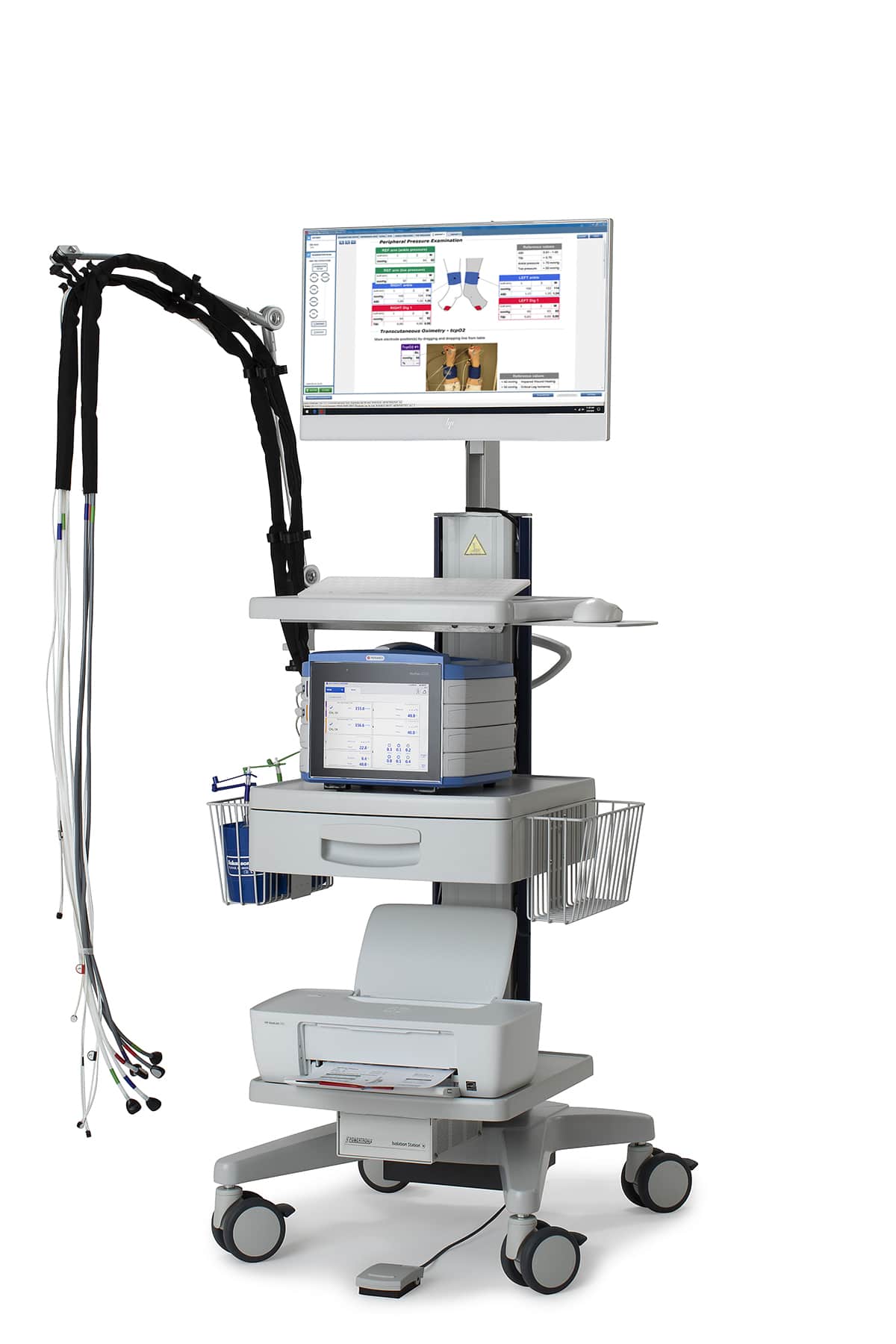Peripheral artery disease (PAD)
![]()
With an increasing population of patients with diabetes that is often asymptomatic and with falsely normal or high ankle-brachial index (ABI) values due to calcified vessels, detecting peripheral artery disease (PAD) has changed in recent years. 20-30 % of diabetics have calcified vessels. For reliable noninvasive vascular tests, look instead to toe pressure, pulse volume recording (PVR), and transcutaneous oxygen pressure (TcpO2).
Peripheral artery disease (PAD) is a condition caused by obstruction of the peripheral arteries, leading to an increased risk for cardiovascular events and premature death. The classic peripheral artery disease (PAD) symptom is intermittent claudication or walking pain, but notably, two-thirds of all patients are asymptomatic. Early diagnosis and treatment using noninvasive vascular tests are crucial to saving lives.
Diabetic foot disease, mainly due to neuropathy, peripheral artery disease, and/or infection, often leads to ulceration and possible subsequent limb amputation. It is one of the most costly complications of diabetes.
Why is the diagnosis more complex in patients with diabetes?
- Calcified vessels
- Neuropathy
- Multiple lesions with slow healing potential
- Asymptomatic
- Less collateral flow
- Microcirculatory issues
- Perfusion deficit is greater
All-in-one simultaneous assessment
PeriFlux 6000 Combined System offers the unique capability to simultaneously assess both toe pressure and PVR as well as measure transcutaneous oxygen pressure in the tissue with one system saving limbs, lives, and reducing human suffering.
User-friendly software guides the user throughout the examination with a standardized measurement procedure for reliable and reproducible results.
A comprehensive report is generated with all clinical information clearly visible with curves adding clarity. The report, as well as the workflow, can be customized to suit processes in clinical situations worldwide.
Perfusion imaging for PAD and diabetic foot ulcers
Perimed was the first company to commercialize laser-based microcirculation imaging and has over the past 40 years been the world leader in perfecting those techniques.
PeriCam PSI provides a fast and accurate way to assess microcirculation in tissue by using laser speckle contrast analysis (LASCA or LSCI). It fits into the growing demand for noninvasive imaging techniques in diagnostics. All major guidelines [ref 1,2,3] on diagnosis and management of peripheral artery disease (PAD) and diabetic foot ulcers recognize the need for microcirculation assessment. The International Working Group on the Diabetic Foot (IWGDF) also highlights the need to investigate the role of novel methods of perfusion assessment [ref 3].
LSCI as a possible diagnostic technique
Recent expert reviews mentioned LSCI as a possible diagnostic technique to determine tissue perfusion in patients with peripheral artery disease (PAD)[ref 4] and/or diabetic foot ulcers [ref 5] and PeriCam PSI has shown to be a promising tool in these assessments [ref 6,7]. It can offer several advantages compared to other diagnostic techniques:
- Noninvasive
- No contact with patient
- No need for injectable contrast agents
- No ionizing radiation
- Ease of use
- Intuitive and powerful software for measurement setup, recording, and analysis
- Small format system offers great flexibility in busy and crowded environments
- Easy to position due to flexible arm and ball head mount.
- Fast
- Real time imaging: up to ~100 images per second
Pericam PSI Imaging system is clinically approved for measurement of microcirculation in the USA, Europe, China, and many other markets.
References:
- Conte MS, Bradbury AW, Kolh P, et. al, Global Vascular Guidelines on the Management of Chronic Limb-Threatening Ischemia. Eur J Vasc Endovasc Surg. 2019 Jul;58(1S):S1-S109.e33. doi: 10.1016/j.ejvs.2019.05.006.
- Mills JL, Conte MS, Armstrong DG, et al. The Society for Vascular Surgery Lower Extremity Threatened Limb Classification System: Risk stratification based on Wound, Ischemia, and foot Infection (WIfI). J Vasc Surg. 2014;59(1):220034.e1-2. DOI: 10.1016/j.jvs.2013.08.003
- Hinchliffe et al. Guideline on diagnosis, prognosis and management of peripheral artery disease among people with diabetes (IWGDF 2019 update). Diab Metab Res Rev. 2020. e3276 DOI: 10.1002/dmrr.3276
- Kirsten F. Ma, Simone F. Kleiss, Richte C.L. Schuurmann, Reinoud P.H. Bokkers, Çagdas Ünlü & Jean-Paul P.M. De Vries (2019) A systematic review of diagnostic techniques to determine tissue perfusion in patients with peripheral arterial disease, Expert Review of Medical Devices, 16:8, 697-710, DOI: 10.1080/17434440.2019.1644166
- Onno A. Mennes, Jaap J. van Netten, Riemer H.J.A. Slart and Wiendelt Steenbergen, “Novel Optical Techniques for Imaging Microcirculation in the Diabetic Foot”, Current Pharmaceutical Design (2018) 24: 1304. DOI: 10.2174/1381612824666180302141902
- Anne Humeau-Heurtier, Pierre Abraham, Samir Henni, Bi-dimensional variational mode decomposition of laser speckle contrast imaging data: A clinical approach to critical limb ischemia?, Computers in Biology and Medicine 86, 2017, 107-112 DOI: 10.1016/j.compbiomed.2017.05.012
- A. Mennes, J.J. van Netten, J.G. van Baal, W. Steenbergen, Assessment of microcirculation in the diabetic foot with laser speckle contrast imaging, Physiological Measurement 40 065002 DOI: 10.1088/1361-6579/ab2058
PeriFlux 6000
Combined System –
Instructional Video
PeriCam PSI NR –
Assessment of microcirculation
in the diabetic foot
ESVS Educational Video –
Prof. Pirkka Vikatmaa
Helsinki University Hospital
Peripheral Arterial Disease –
Diagnosis in patients
with diabetes
by Prof. R. Hinchliffe
Please fill in the form to get more information
Disclaimer: It is possible that the products on the Perimed website may not be cleared for sale in all markets.



